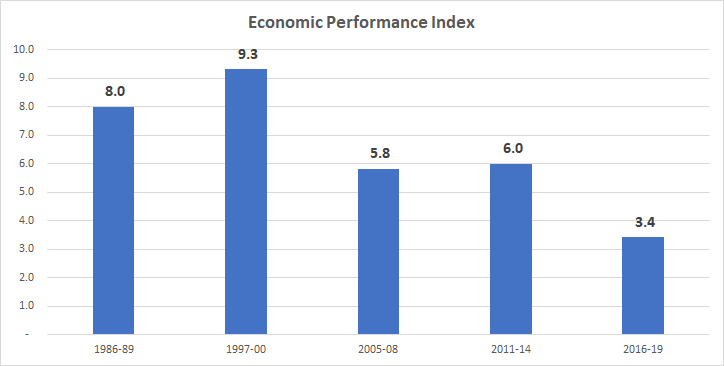Scoring the economic performance of Canada’s last five prime ministers

Our recent study, Comparing Economic Performance in Five Pre-Recession Periods, examined a number of measures of income growth, labour market performance and business investment for the Canadian economy for the four-year periods before the last five recessions/economic slowdowns. Specifically, it examined data for 1986-89, 1997-00, 2005-08, 2011-14 and 2016-19. The conclusion was that the 2016-19 period had the weakest economic performance of the five periods analyzed.
We received several inquiries about whether there was a way to aggregate the results in the three different areas to better illustrate the weakness of the Canadian economy going into the 2020 recession. This blog builds on the data presented in the original study by calculating an index of economic performance based on three areas of performance: (1) income growth, (2) labour market performance, and (3) business investment.
The table below contains the scores for each of the three areas. The scores were calculated by using the range between the highest score and zero, and making the best score 10.0. The average rate of growth in GDP per person (inflation-adjusted) was used as the single measure for income growth.
| Time Period | Prime Minister | Overall Score | Income Growth | Labour | Business Investment |
|---|---|---|---|---|---|
| 1986-89 | Mulroney | 8.0 | 5.0 | 9.0 | 10.0 |
| 1997-00 | Chretien | 9.3 | 10.0 | 8.7 | 9.3 |
| 2005-08 | Martin/Harper | 5.8 | 3.3 | 7.9 | 6.3 |
| 2011-14 | Harper | 6.0 | 4.1 | 7.7 | 6.3 |
| 2016-19 | Trudeau | 3.4 | 2.1 | 8.2 | - |
Prime Minister Chrétien (1997-00) recorded the highest average annual rate of growth in per person GDP at 3.7 per cent and received a score of 10.0. The lowest average annual rate of growth income per-person GDP was experienced during the Justin Trudeau era (0.8 per cent) and he received a score of 2.1.
The average annual change in total business investment (adjusted for inflation) including residential structures was used as the single measure for business investment. Prime Minister Mulroney experienced the highest average annual increase in business investment (adjusted for inflation) at 8.1 per cent and received a score of 10.0. Prime Minister Trudeau again experienced the lowest average annual rate of growth—it actually declined—in total business investment of -0.2 per cent and received a score of 0.0 because of the average annual negative growth.
Three measures were used to assess labour market performance due to the complexities noted in the original study related to fluctuating rates of labour market participation—that is, the number of people over the age of 15 active in the labour market (see figure 7 in the original study). The average unemployment rate, average growth in private-sector employment and average rate of employment (as a share of the population over the age of 15) were used to calculate the score for overall labour market performance.
The overall scores for labour market performance are much closer to one another than the previous two measures. Specifically, the highest score (9.0) was recorded in the Mulroney era while the lowest (7.7) was experienced during the Harper era.
As discussed in the study, lower unemployment rates were generally experienced post-2000 and, in particular, during the 2005-08 and 2016-19 periods (see figure 6 in the original study). However, the rates of private-sector job-creation were also weaker post-2000 (see figure 8 in the original study). Alternatively, the pre-2000 period, specifically the Mulroney and Chrétien eras, experienced much stronger private-sector job-creation but also higher average unemployment rates. One reconciling explanation is the variation in the labour force participation rate over this entire time period. For example, the average labour force participation rate during the 2016-19 period was 65.7 per cent compared to 67.3 per cent during 2005-08.
When all three areas of performance are combined to create one score (see chart below), based on equal weighting of all three components, Prime Minister Chrétien receives the highest score of 9.3 for economic performance followed by Prime Minister Mulroney at 8.0. Prime Minister Trudeau receives the lowest score of 3.4 (this is the only four-year period to record a score of less than 5.0. The low score reflects the comparative weakness of the economy during the 2016-19 period under Prime Minister Trudeau.


